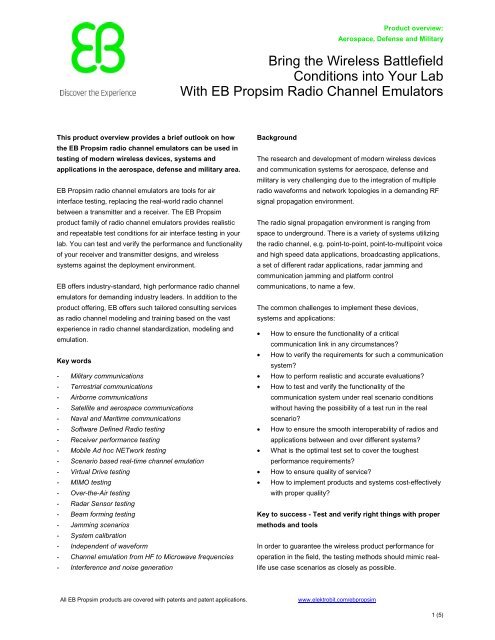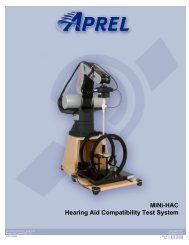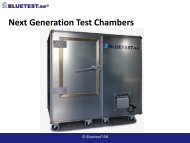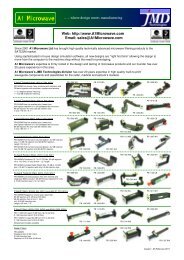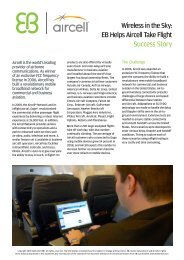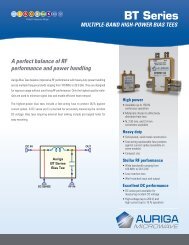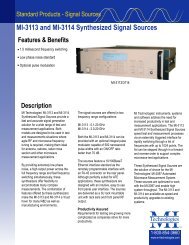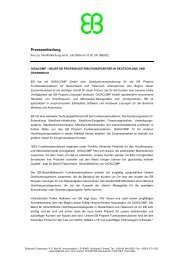EB Propsim Product Overview_ Aerospace, Fefense ... - Gigacomp
EB Propsim Product Overview_ Aerospace, Fefense ... - Gigacomp
EB Propsim Product Overview_ Aerospace, Fefense ... - Gigacomp
You also want an ePaper? Increase the reach of your titles
YUMPU automatically turns print PDFs into web optimized ePapers that Google loves.
<strong>Product</strong> overview:<br />
<strong>Aerospace</strong>, Defense and Military<br />
Bring the Wireless Battlefield<br />
Conditions into Your Lab<br />
With <strong>EB</strong> <strong>Propsim</strong> Radio Channel Emulators<br />
This product overview provides a brief outlook on how<br />
the <strong>EB</strong> <strong>Propsim</strong> radio channel emulators can be used in<br />
testing of modern wireless devices, systems and<br />
applications in the aerospace, defense and military area.<br />
<strong>EB</strong> <strong>Propsim</strong> radio channel emulators are tools for air<br />
interface testing, replacing the real-world radio channel<br />
between a transmitter and a receiver. The <strong>EB</strong> <strong>Propsim</strong><br />
product family of radio channel emulators provides realistic<br />
and repeatable test conditions for air interface testing in your<br />
lab. You can test and verify the performance and functionality<br />
of your receiver and transmitter designs, and wireless<br />
systems against the deployment environment.<br />
<strong>EB</strong> offers industry-standard, high performance radio channel<br />
emulators for demanding industry leaders. In addition to the<br />
product offering, <strong>EB</strong> offers such tailored consulting services<br />
as radio channel modeling and training based on the vast<br />
experience in radio channel standardization, modeling and<br />
emulation.<br />
Key words<br />
- Military communications<br />
- Terrestrial communications<br />
- Airborne communications<br />
- Satellite and aerospace communications<br />
- Naval and Maritime communications<br />
- Software Defined Radio testing<br />
- Receiver performance testing<br />
- Mobile Ad hoc NETwork testing<br />
- Scenario based real-time channel emulation<br />
- Virtual Drive testing<br />
- MIMO testing<br />
- Over-the-Air testing<br />
- Radar Sensor testing<br />
- Beam forming testing<br />
- Jamming scenarios<br />
- System calibration<br />
- Independent of waveform<br />
- Channel emulation from HF to Microwave frequencies<br />
- Interference and noise generation<br />
Background<br />
The research and development of modern wireless devices<br />
and communication systems for aerospace, defense and<br />
military is very challenging due to the integration of multiple<br />
radio waveforms and network topologies in a demanding RF<br />
signal propagation environment.<br />
The radio signal propagation environment is ranging from<br />
space to underground. There is a variety of systems utilizing<br />
the radio channel, e.g. point-to-point, point-to-multipoint voice<br />
and high speed data applications, broadcasting applications,<br />
a set of different radar applications, radar jamming and<br />
communication jamming and platform control<br />
communications, to name a few.<br />
The common challenges to implement these devices,<br />
systems and applications:<br />
• How to ensure the functionality of a critical<br />
communication link in any circumstances?<br />
• How to verify the requirements for such a communication<br />
system?<br />
• How to perform realistic and accurate evaluations?<br />
• How to test and verify the functionality of the<br />
communication system under real scenario conditions<br />
without having the possibility of a test run in the real<br />
scenario?<br />
• How to ensure the smooth interoperability of radios and<br />
applications between and over different systems?<br />
• What is the optimal test set to cover the toughest<br />
performance requirements?<br />
• How to ensure quality of service?<br />
• How to implement products and systems cost-effectively<br />
with proper quality?<br />
Key to success - Test and verify right things with proper<br />
methods and tools<br />
In order to guarantee the wireless product performance for<br />
operation in the field, the testing methods should mimic reallife<br />
use case scenarios as closely as possible.<br />
All <strong>EB</strong> <strong>Propsim</strong> products are covered with patents and patent applications.<br />
www.elektrobit.com/ebpropsim<br />
1 (5)
<strong>Product</strong> overview:<br />
<strong>Aerospace</strong>, Defense and Military<br />
The wireless products can be field tested in a test setup that<br />
matches the intended use scenario. This could include for<br />
example performing drive testing with a measurement device<br />
through a coverage area of a radio network or measurements<br />
on different operational areas of RF sensors. Field testing is<br />
an essential part of wireless product, wireless system and<br />
applications development.<br />
It is a known fact that field testing is generally a laborintensive,<br />
time-consuming and expensive process - and<br />
sometimes even impossible to perform in advance with<br />
wireless equipment operating in some locations. When<br />
performing testing in the field, the testing of different<br />
environments requires physically moving the testing<br />
equipment to another geographical location. Field testing<br />
results are specific to the environment, location and time.<br />
They are non-repeatable, even under the exact same test<br />
setup, location and test scenario conditions. This is due to<br />
the fact that with field testing there is no real control over the<br />
natural environment or the radio channel effects.<br />
The benefit of radio channel emulation is that it enables<br />
accurate, controllable and fully repeatable test runs to be<br />
performed in a laboratory environment. Testing through radio<br />
channel emulation can be used to complement – or in some<br />
cases even replace – traditional field testing. Emulator testing<br />
significantly reduces the testing time and cost for a variety of<br />
standard and specific radio environments. With a radio<br />
channel emulator it is possible to test product performance<br />
during one test session in any environment such as indoor,<br />
metropolitan, highway, rural or mountainous areas. Faster<br />
testing cycles lead to shorter development cycles with<br />
reduced costs and with the excellent performance, maturity<br />
and reliability of the wireless product, systems and<br />
applications.<br />
The <strong>EB</strong> <strong>Propsim</strong> radio channel emulators provide unique<br />
emulation capabilities from HF to Microwave frequencies<br />
enabling users to implement and run the test scenarios in<br />
realistic environments under laboratory conditions with the<br />
highest accuracy and repeatability available.<br />
A more sophisticated approach to testing wireless products<br />
compared to field tests is to emulate the radio channel in a<br />
controlled laboratory environment. With this approach the<br />
radio channel is replaced with a radio channel emulator,<br />
which takes all the radio channel phenomena into account.<br />
The radio channel emulator is a test and measurement<br />
device connected between the transmitter and the receiver.<br />
The transmission passes through the emulator, which<br />
recreates e.g. path loss, shadowing, multipath fading, delay<br />
spread, Doppler spread, angle spread and polarization<br />
effects as well as provides the option for the addition of noise<br />
and interference. Figure 1 illustrates the principle of radio<br />
channel emulation testing.<br />
Receiver performance and application testing<br />
Figure 2 shows the received signal amplitude as a function of<br />
time in an urban environment. The total signal can be divided<br />
and categorized into a path loss component, shadowing<br />
effects (corner effects or toggling between Line Of Sight and<br />
Non-Line Of Sight states between transmitter and receiver)<br />
and fast fading effects (sum of multipath signals between<br />
mobile transmitter and receiver).<br />
Figure 2. Example of multipath signal received in mobile radio<br />
Base station<br />
<strong>EB</strong> <strong>Propsim</strong> F8<br />
Mobile terminal<br />
receiver in a typical urban environment.<br />
Figure 1. Typical test setup with a stand-alone radio channel<br />
emulator and transceivers under testing<br />
All <strong>EB</strong> <strong>Propsim</strong> products are covered with patents and patent applications.<br />
www.elektrobit.com/ebpropsim<br />
2 (5)
<strong>Product</strong> overview:<br />
<strong>Aerospace</strong>, Defense and Military<br />
Typical items to be tested and measured with the supported<br />
waveforms of the receiver are:<br />
• Receiver sensitivity level<br />
• AGC<br />
• Intersymbol/Intercarrier Interference<br />
• Channel Estimation algorithms<br />
• Diversity/MIMO DSP Algorithms<br />
• Synchronization<br />
• Min/max delay-Doppler<br />
• SNR<br />
• Interference mitigation<br />
All these functions of the receiver should be tested and<br />
verified against realistic phenomena that are occurring in the<br />
real wireless environment, where the receiver is to be<br />
exposed. Figure 3 shows the signal path inside a typical<br />
digital receiver.<br />
For the testing of air-to-ground links a proper radio channel<br />
emulator with excellent radio channel modeling and<br />
emulation capabilities is needed.<br />
Network level system and application testing<br />
Today the communication network in defense and military is<br />
the so-called Mobile Ad hoc NETwork (MANET), where<br />
multiple radios are communicating with each other. See<br />
Figure 6 (on next page).<br />
The radios in this type of network are called Cognitive radios.<br />
Figure 5 describes the main features of Cognitive radios and<br />
communication systems.<br />
Cognitive Communication Systems<br />
Cooperation Cross-layer Scheduling<br />
Link adaptation<br />
Space<br />
Flexible air interface<br />
Time<br />
Frequency<br />
(cognitive radio)<br />
Figure 5. Features of a cognitive communication system<br />
Figure 3. Signal processing in a typical digital receiver.<br />
The air-to-ground link (broadcast or communication) includes<br />
both terrestrial and satellite environments and therefore the<br />
receiver must handle the characteristics of both of them. E.g.<br />
phase continuous delay/Doppler with extremely high<br />
velocities, path delay, path loss, rain effects, multipath fast<br />
fading, shadowing and Doppler due to terrestrial<br />
environment. See Figure 4.<br />
A cognitive radio is an intelligent radio, which can change its<br />
transmission or reception parameters to communicate<br />
efficiently avoiding interference with undesired signals.<br />
Cognitive systems have several items (not only frequency) to<br />
be cognitive, e.g. adaptive modulation and coding,<br />
retransmission, cross-layer optimization, awareness of user<br />
requirements (QoS, throughput etc.), adaptive scheduling,<br />
etc. Most of them are related to the radio channel conditions.<br />
With <strong>EB</strong> <strong>Propsim</strong> real-world radio channel emulators the<br />
cognitive radios are easy and efficient to develop and<br />
test in laboratory conditions.<br />
Figure 4. Air-to-ground channel emulation process.<br />
All <strong>EB</strong> <strong>Propsim</strong> products are covered with patents and patent applications.<br />
www.elektrobit.com/ebpropsim<br />
3 (5)
<strong>Product</strong> overview:<br />
<strong>Aerospace</strong>, Defense and Military<br />
Figure 6. Mobile Ad hoc NETwork scenario in a battlefield (source: http://jpeojtrs.mil/)<br />
Figure 7 shows on general level the example test setup for<br />
MANET testing in laboratory conditions – Hardware-In-a-<br />
Loop testing. The maximum number of radios and the<br />
needed connections between radios in testing define the<br />
number of emulation channels and emulators needed.<br />
Scenario runs can be based on a set of pre-defined<br />
emulation files that can be loaded from the user library.<br />
Alternatively the scenario runs can be based on the real-time<br />
dynamic control of the parameters of each emulation<br />
channel: e.g. attenuation, multipath properties, velocities etc.,<br />
interference and noise levels can be controlled in real-time.<br />
Channel model definition for the scenarios could be based on<br />
field measured data (GPS data, loggers, scanners, test<br />
receivers, channel sounders) if available or on pure synthetic<br />
or standard channel models or profiles.<br />
antenna_3.jpg<br />
There are multiple 3rd party tools that can be utilized in the<br />
definition of the scenarios and the channel model library. As<br />
an example most ray tracing simulation software or<br />
application specific scenario planning tools can be utilized in<br />
the definition of the scenario data for the real-world radio<br />
channel emulation.<br />
Figure 7. Example on MANET test setup in laboratory conditions –<br />
Hardware-In-a-Loop testing.<br />
The physical connection of radios to the emulation channels<br />
is done via interfacing unit(s) (IFU) provided by <strong>EB</strong>. Each<br />
emulator can be used locally or all emulators can be remote<br />
controlled with control scripts or by a software application that<br />
is running on an external PC over a LAN network.<br />
All <strong>EB</strong> <strong>Propsim</strong> products are covered with patents and patent applications.<br />
www.elektrobit.com/ebpropsim<br />
4 (5)
<strong>Product</strong> overview:<br />
<strong>Aerospace</strong>, Defense and Military<br />
Brief summary of other testing capabilities for<br />
aerospace, defense and military<br />
<strong>EB</strong> <strong>Propsim</strong> emulators support MIMO transceiver testing.<br />
The MIMO technology can be used for improved<br />
performance, either as extended coverage or as higher data<br />
throughput. The actual MIMO gain is dependent on the<br />
propagation environment; therefore the ability to test against<br />
realistic environment models is essential. <strong>EB</strong> <strong>Propsim</strong><br />
emulators support MIMO topologies from 2x2 up to 8x4 or<br />
even beyond that.<br />
<strong>EB</strong> <strong>Propsim</strong> emulators support testing of beam forming and<br />
anti-jamming techniques in a realistic radio channel<br />
environment. One <strong>EB</strong> <strong>Propsim</strong> F8 supports the testing of up<br />
to 8 antenna elements. By cascading multiple units as a<br />
single radio channel emulator, a higher number of antenna<br />
elements can be supported (the number of antennas is not<br />
limited by the emulator hardware).<br />
<strong>EB</strong> <strong>Propsim</strong> emulators support Over-the-Air (OTA) testing<br />
in an anechoic chamber. OTA testing is especially needed<br />
when the antenna installation of the radio should be included<br />
into the radio testing.<br />
<strong>EB</strong> <strong>Propsim</strong> emulators can be used in radar sensor testing<br />
and in radar calibration. Static and dynamic test scenarios<br />
can be created – e.g. testing of a radar altimeter, radar<br />
ranging, creation of moving targets for radar, anti-jamming<br />
features, passive radar sensors etc.<br />
<strong>EB</strong> offers industry-standard, high performance radio channel<br />
emulators for demanding industry leaders. In addition to the<br />
product offering, <strong>EB</strong> offers such tailored consulting services<br />
as radio channel modeling and training based on the vast<br />
experience in radio channel standardization, modeling and<br />
emulation.<br />
For further information please refer to <strong>EB</strong> <strong>Propsim</strong> product<br />
datasheets at:<br />
http://www.elektrobit.com/what_we_deliver/wireless_commun<br />
ications_tools or contact us by emailing<br />
rcpsales@elektrobit.com.<br />
All <strong>EB</strong> <strong>Propsim</strong> products are covered with patents and patent applications.<br />
www.elektrobit.com/ebpropsim<br />
5 (5)


